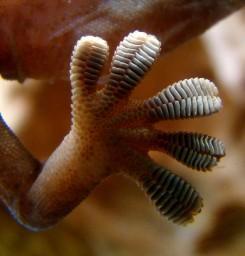A group of researchers at the
University of Massachusetts Amherst has developed a novel adhesive material that is based on gecko feet. The tape, which they have dubbed “Geckskin,” is capable of holding 700 pounds on a smooth wall. From biologist Duncan Irschick’s explanation of the properties of gecko feet, it is easy to see why the researchers were interested in emulating them:
Amazingly, gecko feet can be applied and disengaged with ease, and with no sticky residue remaining on the surface.
Group leader Alfred Crosby described the Geckskin device:
Our Geckskin device is about 16 inches square, about the size of an index card, and can hold a maximum force of about 700 pounds while adhering to a smooth surface such as glass.
How can it be used? Crosby has suggested such uses as securing heavy objects, including computers and televisions, to walls, as well as medical and industrial uses. The UMass press release on the device describes using Geckskin to stick a 42-inch television to a smooth wall. Removing the Geckskin device is as simple as giving it a gentle tug – it leaves no residue behind and can be reused many times. This author would not necessarily recommend trying that at home because not all wall materials, or surfaces, are equal. This is not the first time we have heard about scientists mimicking gecko biology in adhesives. Last fall, a
team of researchers from the Zoological Institute at the
University of Kiel, Germany, produced a tape that bonds to a target surface using the same principal that allows geckos and insects to walk on ceilings. Previous studies have focused on the tiny hairs, called setae, which cover the lizards’ feet. This, claims Irschick, has limited their success. The difference with the Geckskin device is that the researchers have incorporated other features of gecko biology in their design – they have taken into account the way that the tendons, bones and skin interact together. The technology was described in a University of Massachusetts press release:
The key innovation by Bartlett and colleagues was to create an integrated adhesive with a soft pad woven into a stiff fabric, which allows the pad to "drape" over a surface to maximize contact. Further, as in natural gecko feet, the skin is woven into a synthetic "tendon," yielding a design that plays a key role in maintaining stiffness and rotational freedom.
The study was partially funded with a grant from the U.S. Defense Advanced Research Projects Agency (DARPA) through a subcontract to Draper Laboratories and through funding from the University of Massachusetts. The full results of the study can be seen in
Advanced Materials.


